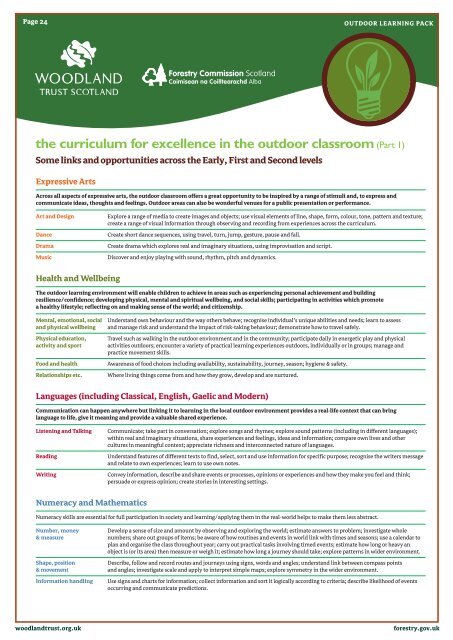2nSbdOqrV
2nSbdOqrV
2nSbdOqrV
Create successful ePaper yourself
Turn your PDF publications into a flip-book with our unique Google optimized e-Paper software.
Page 124OUTDOOR LEARNING PACKthe curriculum for excellence in the outdoor classroom (Part 1)Some links and opportunities across the Early, First and Second levelsExpressive ArtsAcross all aspects of expressive arts, the outdoor classroom offers a great opportunity to be inspired by a range of stimuli and, to express andcommunicate ideas, thoughts and feelings. Outdoor areas can also be wonderful venues for a public presentation or performance.Art and DesignDanceDramaMusicExplore a range of media to create images and objects; use visual elements of line, shape, form, colour, tone, pattern and texture;create a range of visual information through observing and recording from experiences across the curriculum.Create short dance sequences, using travel, turn, jump, gesture, pause and fall.Create drama which explores real and imaginary situations, using improvisation and script.Discover and enjoy playing with sound, rhythm, pitch and dynamics.Health and WellbeingThe outdoor learning environment will enable children to achieve in areas such as experiencing personal achievement and buildingresilience/confidence; developing physical, mental and spiritual wellbeing, and social skills; participating in activities which promotea healthy lifestyle; reflecting on and making sense of the world; and citizenship.Mental, emotional, socialand physical wellbeingPhysical education,activity and sportFood and healthRelationships etc.Understand own behaviour and the way others behave; recognise individual’s unique abilities and needs; learn to assessand manage risk and understand the impact of risk-taking behaviour; demonstrate how to travel safely.Travel such as walking in the outdoor environment and in the community; participate daily in energetic play and physicalactivities outdoors; encounter a variety of practical learning experiences outdoors, individually or in groups; manage andpractice movement skills.Awareness of food choices including availability, sustainability, journey, season; hygiene & safety.Where living things come from and how they grow, develop and are nurtured.Languages (including Classical, English, Gaelic and Modern)Communication can happen anywhere but linking it to learning in the local outdoor environment provides a real-life context that can bringlanguage to life, give it meaning and provide a valuable shared experience.Listening and TalkingReadingWritingCommunicate; take part in conversation; explore songs and rhymes; explore sound patterns (including in different languages);within real and imaginary situations, share experiences and feelings, ideas and information; compare own lives and othercultures in meaningful context; appreciate richness and interconnected nature of languages.Understand features of different texts to find, select, sort and use information for specific purpose; recognise the writers messageand relate to own experiences; learn to use own notes.Convey information, describe and share events or processes, opinions or experiences and how they make you feel and think;persuade or express opinion; create stories in interesting settings.Numeracy and MathematicsNumeracy skills are essential for full participation in society and learning/applying them in the real-world helps to make them less abstract.Number, money& measureShape, position& movementInformation handlingDevelop a sense of size and amount by observing and exploring the world; estimate answers to problem; investigate wholenumbers; share out groups of items; be aware of how routines and events in world link with times and seasons; use a calendar toplan and organise the class throughout year; carry out practical tasks involving timed events; estimate how long or heavy anobject is (or its area) then measure or weigh it; estimate how long a journey should take; explore patterns in wider environment.Describe, follow and record routes and journeys using signs, words and angles; understand link between compass pointsand angles; investigate scale and apply to interpret simple maps; explore symmetry in the wider environment.Use signs and charts for information; collect information and sort it logically according to criteria; describe likelihood of eventsoccurring and communicate predictions.woodlandtrust.org.ukforestry.gov.uk


